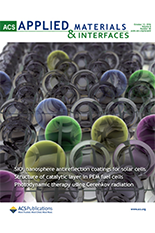NEES News
Solar cells improved with nanospheres is subject of ACS journal cover
The cover of the October 12, 2016 issue of ACS Applied Materials & Interfaces features the work of Prof. Jeremy Munday (ECE, IREAP, NanoCenter) , Prof. Marina Leite (MSE, IREAP, NanoCenter) and IREAP graduate students Dongheon Ha and Chen Gong. Abstract: To increase the power conversion efficiency of solar cells, improved antireflection coatings are needed to couple light into the cell with minimal parasitic loss. Here, we present measurements and simulations of an antireflection coating based on silicon dioxide (SiO2) nanospheres that improve solar cell absorption by coupling light from free space into the absorbing layer through excitation of modes within the nanospheres. The deposited monolayer of nanospheres leads to a significant increase in light absorption within an underlying semiconductor on the order of 15–20%. When the periodicity and spacing between the nanospheres are varied, whispering gallery-like modes can be excited and tuned throughout the visible spectrum. The coating was applied to a Si solar cell containing a Si3N4 antireflection layer, and an additional increase in the spectral current density of ∼5% was found. The fabrication process, involving Meyer rod rolling, is scalable and inexpensive and could enable large-scale manufacturability of microresonator-based photovoltaics. Demonstration of Resonance Coupling in Scalable Dielectric Microresonator Coatings for Photovoltaics Dongheon Ha, Chen Gong, Marina S. Leite, and Jeremy N. Munday ACS Appl. Mater. Interfaces, 8 (37), 24536 (2016)
October 19, 2016 Prev Next |












